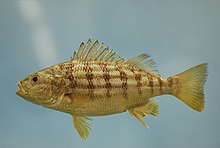Conodon nobilis, the barred grunt, is a species of marine ray-finned fish, a grunt belonging to the family Haemulidae. It is found in the Western Atlantic Ocean where it is a target species for some commercial fisheries.
| Conodon nobilis | |
|---|---|

| |
| Scientific classification | |
| Domain: | Eukaryota |
| Kingdom: | Animalia |
| Phylum: | Chordata |
| Class: | Actinopterygii |
| Order: | Perciformes |
| Family: | Haemulidae |
| Genus: | Conodon |
| Species: | C. nobilis
|
| Binomial name | |
| Conodon nobilis Linnaeus, 1758
| |
| Synonyms[2] | |
| |
Description edit
Conodon nobilis has a relatively robust, elongate, laterally compressed body with a large eye. The upper body is brownish, the abdomen is whitish and there are yellowish horizontal lines along the flanks. They normally show 8 wide dark vertical bars on the back. The soft-rayed part of the dorsal fin, the anal fin and the pelvic fin are yellow.[3] The dorsal fin contains 12 spines and 13 soft rays while the anal fin contains 3 spines and 7 soft rays. This species attains a maximum total length of 33.6 cm (13.2 in), although 25 cm (9.8 in) is more typical.[2]
Distribution edit
Conodon nobilis is found in the western Atlantic Ocean. Its range extends from northeastern Florida to the upper Florida Keys and along the coasts of the Gulf of Mexico westwards from Louisiana to the northern Yucatan Peninsula of Mexico, south through the Caribbean Sea from Hispaniola to Tobago. It is also found along the coast of Central and South American from Mexico south to Argentina.[1]
Habitat and ecology edit
Conodon nobilis is found at depths down to 100 m (330 ft).[1] It occurs largely in sandy coastal areas, although it is also found along rocky shores and in brackish and estuarine waters. It mainly uses the surf zone as a nursery instead of estuaries.[4] It feeds at night, mostly on small fishes and crustaceans,[1] mysids being the most important crustaceans in the diet, with amphipods also being important. There appears to be a peak of recruitment into the Spring.[4]
Systematics edit
Conodon nobilis was first formally described in 1758 as Perca nobilis by Carolus Linnaeus in the 10th edition of the Systema Naturae. The French anatomist Georges Cuvier (1769-1832) described a species he named Conodon antillanus in 1830, creating a new genus, Conodon, for it.[5] Cuvier's C. antillanus was later shown to be a synonym of Linnaeus's Perca nobilis and, thus, this species is the type species of the genus Conodon.[6] The specific name, nobilis, means "notable", "majestic" or "excellent" but Linnaeus did not explain why he chose this adjective.[7]
Utilisation edit
Conodon nobilis is a target for the commercial fisheries, the catch being sold fresh. It is also frequently caught as bycatch in other fisheries, for example it is commonly caught in the fishery for shrimp off Mexico and Brazil. It is also a quarry for sports fishing and appears in the aquarium trade.[1] It is caught using seine nets, trawls and hook and line.[8]
References edit
- ^ a b c d e Anderson, W.; Claro, R.; Cowan, J.; et al. (2017) [errata version of 2015 assessment]. "Conodon nobilis". IUCN Red List of Threatened Species. 2015: e.T194414A115334448. doi:10.2305/IUCN.UK.2015-4.RLTS.T194414A2333473.en. Retrieved 25 March 2021.
- ^ a b Froese, Rainer; Pauly, Daniel (eds.) (2019). "Conodon nobilis" in FishBase. December 2019 version.
- ^ "Species: Conodon nobilis, Barred grunt". Shorefishes of the Greater Caribbean online information. Smithsonian Tropical Research Institute. Retrieved 26 March 2021.
- ^ a b Maíra Pombo; Márcia Regina Denadai; Eduardo Bessa; Flávia Borges Santos; Vanessa Hermann de Faria; Alexander Turra (2014). "The barred grunt Conodon nobilis (Perciformes: Haemulidae) in shallow areas of a tropical bight: spatial and temporal distribution, body growth and diet". Helgoland Marine Research. 68: 271–279.
- ^ Eschmeyer, William N.; Fricke, Ron & van der Laan, Richard (eds.). "Species in the genus Conodon". Catalog of Fishes. California Academy of Sciences. Retrieved 25 March 2021.
- ^ Eschmeyer, William N.; Fricke, Ron & van der Laan, Richard (eds.). "Genera in the family Haemulidae". Catalog of Fishes. California Academy of Sciences. Retrieved 22 March 2021.
- ^ Christopher Scharpf; Kenneth J. Lazara, eds. (5 January 2021). "Order LUTJANIFORMES: Families HAEMULIDAE and LUTJANIDAE". The ETYFish Project Fish Name Etymology Database. Christopher Scharpf and Kenneth J. Lazara. Retrieved 23 March 2021.
- ^ Lindeman, K.C. (2002). "Haemulidae". In Kent E. Carpenter (ed.). The living marine resources of the Western Central Atlantic. Vol. 3: Bony fishes part 2 (Opistognathidae to Molidae) (PDF). FAO Species Identification Guides for Fisheries Purposes. American Society of Ichthyologists and Herpetologists Special Publication No. 5. FAO of the U.N., Rome. pp. 1522–1550.
